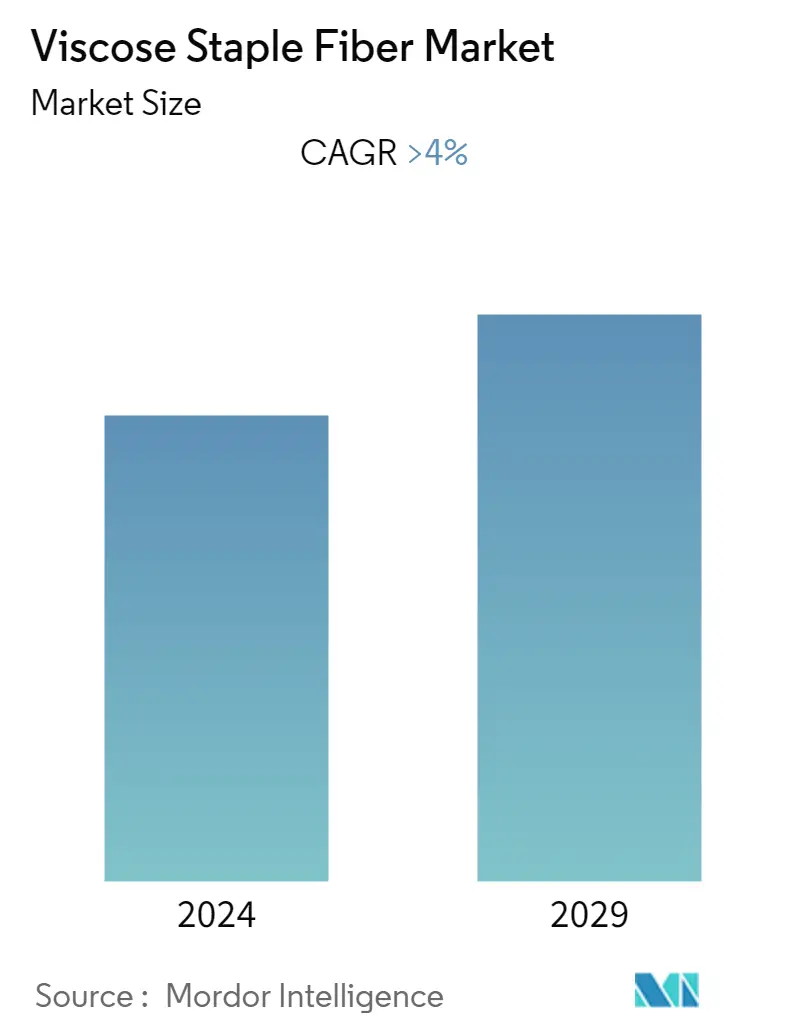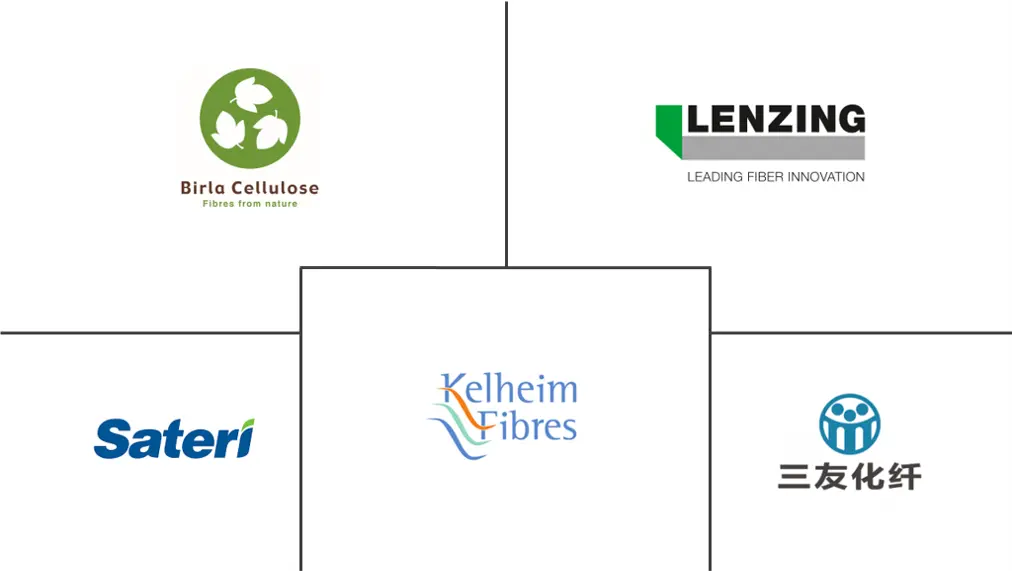Market Size of Viscose Staple Fiber Industry

| Study Period | 2019 - 2029 |
| Base Year For Estimation | 2023 |
| CAGR | 4.00 % |
| Fastest Growing Market | Asia Pacific |
| Largest Market | Asia Pacific |
| Market Concentration | High |
Major Players
*Disclaimer: Major Players sorted in no particular order |
Viscose Staple Fibre Market Analysis
The viscose staple fiber market is projected to register a CAGR of over 4% during the forecast period.
The COVID-19 pandemic has significantly impacted the value chain in every aspect. Because of the government's limitations, the supply of raw materials came to a standstill. As a result of the lockdowns in several countries, viscose fiber prices have dropped, forcing many companies, such as Lenzing AG, to start making safety masks at their factories, as non-woven fibers are needed for mask manufacturing. The pandemic had a detrimental influence on the market, particularly in automobile and garment applications. However, the industry saw marginal growth in 2021, as several firms have begun to produce woven textiles in their facilities. In the scheduled time, the market is expected to grow positively.
- In the short term, the market will be driven by the demand for viscose fiber from the fashion apparel sector.
- Synthetic fibers may hamper the market expansion of viscose fibers.
- Future market opportunities will arise from the growing usage of dense fibers in the medical sector.
- The Asia-Pacific region dominated the market and is also estimated to record the fastest CAGR during the forecast period.
Viscose Staple Fibre Industry Segmentation
A viscous fiber is a type of fiber that has a high resistance to flow. This fiber is often used in textiles and clothing to provide comfort and breathability. Viscous fibers are also known for wicking moisture away from the skin, which can help keep the wearer cool and comfortable. Viscose staple fibers are biodegradable cotton-like fibers. They are made from wood pulp and cotton pulp. The viscose staple fiber market is segmented by application and geography. By application, the market is segmented into woven and non-woven and specialty. The report also covers the market sizes and forecasts for the viscose staple fiber market in 13 countries across the central regions. For each segment, the market sizing and forecasts have been done on the basis of volume (kilotons).
| Application | |||||
| Woven (Textile and Apparel) | |||||
|
| Geography | |||||||
| |||||||
| |||||||
| |||||||
|
Viscose Staple Fiber Market Size Summary
The viscose staple fiber market is anticipated to experience steady growth over the forecast period, driven primarily by the demand from the fashion apparel sector. The market faced significant challenges during the COVID-19 pandemic, which disrupted the supply chain and led to a decline in fiber prices. However, the industry began to recover as companies adapted by producing woven textiles. The Asia-Pacific region, particularly China and India, is expected to dominate the market due to its robust textile industry and increasing demand for apparel. The region's growth is further supported by favorable government policies and the removal of trade duties, which are expected to boost production and export capabilities.
Viscose staple fiber, known for its cotton-like properties, is widely used in various applications, including garments and home textiles. The market's expansion is supported by the growing popularity of natural and biodegradable fibers, which are increasingly favored in the fashion industry. Despite competition from synthetic fibers, the market is poised for growth, with emerging opportunities in the medical sector. The market is consolidated, with major players like Lenzing AG and Birla Cellulose holding significant shares. Innovations in sustainable fiber production, such as those by Sateri, are also contributing to the market's positive outlook.
Viscose Staple Fiber Market Size - Table of Contents
-
1. MARKET DYNAMICS
-
1.1 Drivers
-
1.1.1 Growing Demand for Apparels and Clothing
-
1.1.2 Increased Adoption of Viscose Fabrics, due to Ambiguity in Cotton Prices
-
-
1.2 Restraints
-
1.2.1 Competition from Synthetic Fibers
-
1.2.2 Unfavorable Conditions Arising due to the Impact of COVID-19, Especially in End-user Industries like Automotive and Others
-
-
1.3 Industry Value Chain Analysis
-
1.4 Porter's Five Forces Analysis
-
1.4.1 Bargaining Power of Suppliers
-
1.4.2 Bargaining Power of Consumers
-
1.4.3 Threat of New Entrants
-
1.4.4 Threat of Substitute Products and Services
-
1.4.5 Degree of Competition
-
-
1.5 Production Process
-
1.6 Technological Product Advancement
-
-
2. MARKET SEGMENTATION (Market Size in Volume)
-
2.1 Application
-
2.1.1 Woven (Textile and Apparel)
-
2.1.2 Non-woven and Specialty
-
2.1.2.1 Healthcare
-
2.1.2.2 Automotive
-
2.1.2.3 Other Applications
-
-
-
2.2 Geography
-
2.2.1 Asia-Pacific
-
2.2.1.1 China
-
2.2.1.2 India
-
2.2.1.3 Japan
-
2.2.1.4 South Korea
-
2.2.1.5 Rest of Asia-Pacific
-
-
2.2.2 North America
-
2.2.2.1 United States
-
2.2.2.2 Canada
-
2.2.2.3 Mexico
-
-
2.2.3 Europe
-
2.2.3.1 Germany
-
2.2.3.2 United Kingdom
-
2.2.3.3 Italy
-
2.2.3.4 France
-
2.2.3.5 Rest of Europe
-
-
2.2.4 Rest of the World
-
2.2.4.1 Brazil
-
2.2.4.2 Argentina
-
2.2.4.3 Other Rest of the World
-
-
-
Viscose Staple Fiber Market Size FAQs
What is the current Viscose Staple Fiber Market size?
The Viscose Staple Fiber Market is projected to register a CAGR of greater than 4% during the forecast period (2024-2029)
Who are the key players in Viscose Staple Fiber Market?
LENZING AG, Birla Cellulose , Sateri , Kelheim Fibres GmbH and Tangshan Sanyou Group Xingda Chemical Fibre Co. Ltd are the major companies operating in the Viscose Staple Fiber Market.

